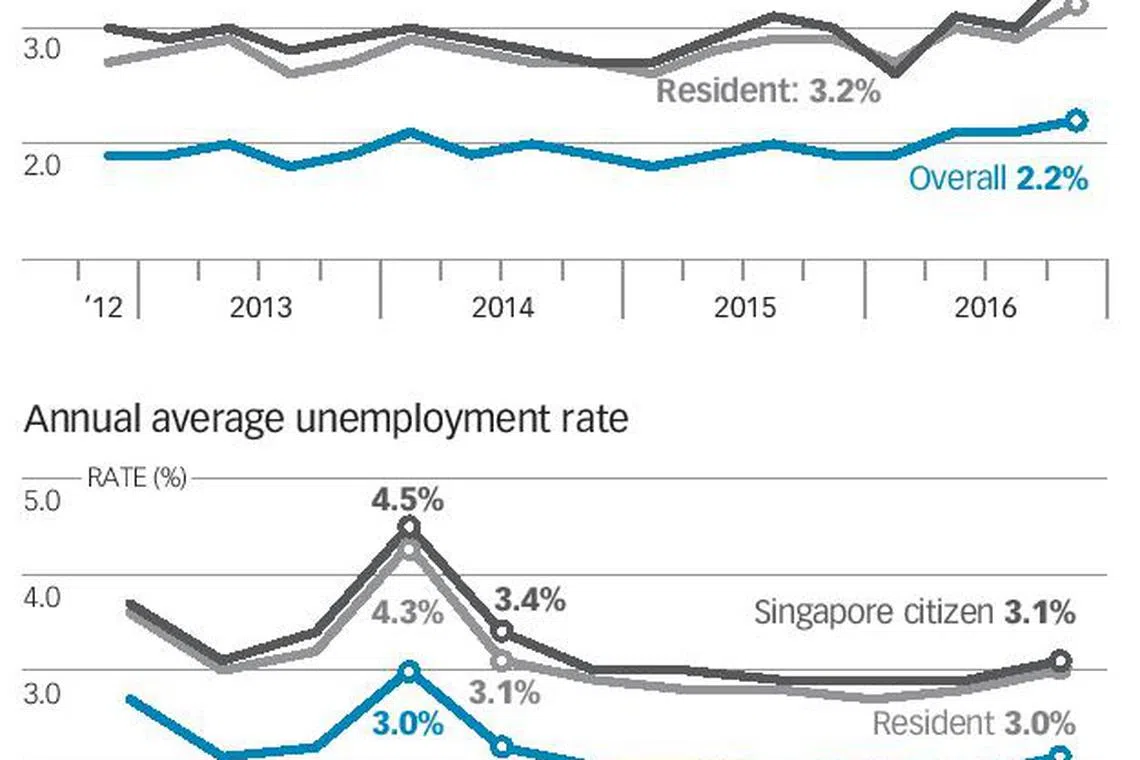2016 unemployment at 6-year high amid more layoffs, fewer vacancies
Jobseekers take longer time to get employed and re-entry into workforce is lower among those who lose their jobs
Singapore
THE labour market in Singapore softened dramatically in 2016, with the jobless rate at a six-year high as layoffs spiked and job vacancies fell.
Jobseekers are finding that it takes longer to get a job and for those who have lost their jobs, fewer of them were re-entering the workforce, according to the Ministry of Manpower's (MOM) Labour Market 2016 report released on Wednesday.
Total employment grew at a slower rate, reflecting cyclical weakness in parts of the economy, a structural slowdown in local labour force growth and tightened foreign worker policy, said MOM.
The overall unemployment rate rose to a seasonally-adjusted 2.2 per cent in December 2016, up from 2.1 per cent in September 2016, in line with MOM's preliminary figures.
In the fourth quarter, the jobless rate among citizens jumped to 3.5 per cent from 3 per cent in the previous quarter, while it rose to 3.2 per cent from 2.9 per cent among residents.
About 73,900 residents, of which 67,300 were citizens, were unemployed in December 2016 - higher than 66,600 residents and 58,500 citizens in September 2016.
For the full-year, the overall unemployment rate edged up to 2.1 per cent in 2016 from 1.9 per cent in 2015. Among residents, the rate was 3 per cent, up from 2.8 per cent, and among citizens, it rose to 3.1 per cent from 2.9 per cent.

Hardest hit were those in their 30s and those 50 and above. The annual average unemployment rate for residents in the 30s rose to 2.3 per cent in 2016 from 1.9 per cent in 2015, while for those aged 50 and above, it rose to 2.7 per cent from 2.4 per cent - also highest since 2010.
Degree holders and those with secondary education saw a larger hike in jobless rate, rising to 3.1 per cent in 2016 from 2.8 per cent and 2.7 per cent, respectively, in 2015. This is the biggest jump since 2009 for degree holders.
More jobseekers also took longer to find work. Notably, the long-term unemployment rate for degree holders rose to a 12-year high of one per cent.
Those jobless for at least 25 weeks climbed to 0.8 per cent in 2016 from 0.6 per cent in 2015. The largest gap up was among residents aged 50 and above, creeping up from 0.7 per cent in 2015 to one per cent in 2016 - the highest since 2009.
Layoffs continued to rise and were higher than the previous quarter and a year ago, with more redundancies in manufacturing and services.
A total of 5,440 workers lost their jobs in Q4 2016, up from the previous quarter's 4,220 workers - the highest since Q2 2009.
Of those made redundant in Q4 2016, 75 per cent were professionals, managers, executives and technicians, 63 per cent aged 40 and above, 46 per cent were degree holders and 57 per cent were men.
The annual average rate of re-entry among residents made redundant fell for the second consecutive year to 48 per cent in 2016 - the lowest since 2010.
The ratio of job vacancies to unemployed persons fell to 77 openings per 100 jobseekers in December 2016 on a seasonally-adjusted basis from 91 in September 2016.
Job vacancies fell to a four-year low of 47,600 in December on a seasonally-adjusted basis from 50,800 in the three months prior.
Despite the gloom, local employment grew, with 11,200 more jobs compared to 700 in 2015. Growth was 96,000 in 2014, 82,900 in 2013 and 58,700 in 2012.
Foreign employment, excluding foreign domestic workers, declined for the first time since 2009's recession by shedding 2,500 jobs, along with tightening of foreign workforce supply. The contractions were mainly in construction and manufacturing.
Total employment also grew albeit slower in the fourth quarter of 2016, adding 2,300 jobs, due to seasonal hiring for year-end festivities, marking a turnaround from third quarter's contraction. The median income continued to grow over the last five years, although slower in 2016.
Despite Q4 GDP recovery, the job market continues to weaken to the softest since global financial crisis.
Citibank economist Kit Wei Zheng said: "With unemployment partly structural, improvements in external demand - even if sustained - may take longer to filter through to the jobs market."
NTUC assistant secretary-general Patrick Tay urged workers and employers to tap initiatives introduced by the government and to "embrace the changes before the change embraces them".
Managing director and country head of Kelly Services Singapore Foo See Yang said companies should look at the transferrable soft skills and right attitudes of talents, to help them ride out future challenges.
Workers should also be more proactive and flexible in jobseeking by applying for jobs within and across industries. "The decreasing number of job vacancies signals that workers need to be realistic in their job expectations and be open to new opportunities that come by," said Mr Foo.
Adecco Personnel (Singapore) director Glennis Chan noted that there are growth sectors worth looking at, such as healthcare services, information and technology, education, and compliance and security.
She said: "Technology is driving throughout most industries. We will see an increase in demand for skills in digital, STEM and analytics."
Copyright SPH Media. All rights reserved.
